Cinematic Pleasures: Fear and Loathing in Las Vegas
by j.d. lafrance
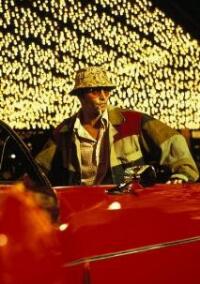 After more than twenty years of failed attempts and missed opportunities, Terry Gilliam has done what many thought impossible - he has transformed Hunter S. Thompson's classic novel, Fear and Loathing in Las Vegas, into the cinematic equivalent of a sledgehammer whacked across your frontal lobes. Thompson's book has been fully realized and brought to the big screen in all of its demented glory.
After more than twenty years of failed attempts and missed opportunities, Terry Gilliam has done what many thought impossible - he has transformed Hunter S. Thompson's classic novel, Fear and Loathing in Las Vegas, into the cinematic equivalent of a sledgehammer whacked across your frontal lobes. Thompson's book has been fully realized and brought to the big screen in all of its demented glory.
Gilliam's film faithfully adapts journalist Raoul Duke (Johnny Depp) and his attorney, Dr. Gonzo's (Benicio Del Toro) trip to Las Vegas to cover the 1971 Mint 400 motorcycle race for Sports Illustrated magazine. However, the competition is merely an excuse for the duo to abuse their expense account and indulge in a galaxy of drugs. What was initially a simple journey to cover a motorcycle race mutates into a bizarre search for the American Dream.
THE BOOK
"As true gonzo journalism, this doesn't work at all, and even if it did, I couldn't possibly admit it. Only a goddamn lunatic would write a thing like this and claim it was true." - Hunter S. Thompson
Originally, Hunter S. Thompson was assigned to write captions for a photo-essay on the Mint 400 off-road motorcycle race in Las Vegas for Sports Illustrated magazine. Along for the ride was his attorney, Oscar Zeta Acosta, whom he had met through a mutual friend. Thompson remembers, "I dragged Oscar away while he was working on the 'Biltmore Seven' trial because we couldn't talk in that war zone. So I said, 'Let's get the hell out of town!'" At some point, the editor for Rolling Stone magazine heard that Thompson was in Vegas and asked him to also cover the National District Attorneys Association's Third Annual Conference on Narcotics and Dangerous Drugs which was being held at Caesar's Palace.
When Sports Illustrated rejected his work Thompson took the Rolling Stone gig. It was at this point that he began to put his weird journey on paper. Truth was truly stranger than fiction as Thompson remembers one incident with his wild attorney: "He would do things like drop me off at the airport in my rental car, and then two months later I'd get a bill for three weeks that he used the car. He'd forget to take it back." Acosta had inspired Thompson to take his writing to a new level: "gonzo journalism," where the journalist participates in the story he is writing about. Taking refuge in a Ramada Inn in Arcadia, California, Thompson wrote relentlessly, frequenting a 24-hour coffee shop and breaking only for the odd swim in the pool. By the time he had returned home to Aspen, Colorado, the writer had a first draft done. In his basement, Thompson blasted the Rolling Stones' "Sympathy For The Devil" while he "anguished over five or six drafts until I got it right."
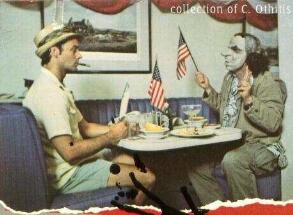 Fear and Loathing in Las Vegas was first published in Rolling Stone magazine in 1971. Thompson invented the Raoul Duke moniker because he was worried that his debauched misadventures depicted in the book might ruin his chances of acquiring press credentials from the White House so that he could cover the 1972 Presidential campaign-hence the Duke byline. Thompson got his credentials and allowed the book publishers to use his real name when the story was released in book form in 1972.
Fear and Loathing in Las Vegas was first published in Rolling Stone magazine in 1971. Thompson invented the Raoul Duke moniker because he was worried that his debauched misadventures depicted in the book might ruin his chances of acquiring press credentials from the White House so that he could cover the 1972 Presidential campaign-hence the Duke byline. Thompson got his credentials and allowed the book publishers to use his real name when the story was released in book form in 1972.
Thompson's book tapped into the cultural zeitgeist at just the right moment by connecting with a disillusioned generation who watched the hopeful '60s transform into the dark and turbulent '70s. Terry Gilliam sees Fear and Loathing as "a book about loss: the Sixties didn't pay off the way Hunter obviously had hoped they would."
WHERE THE BUFFALO ROAM
Many filmmakers over the years had tried to make films out of Hunter S. Thompson's books but the first completed effort didn't surface until 1980 with Where The Buffalo Roam. The writer's agent called him one day and told him that movie producer Thom Mount wanted to buy the rights to "The Banshee Screams for Buffalo Meat," a eulogy for Oscar Acosta, for $100,000. Thompson's expectations weren't that high. "So to me it was just another option job. Then all of a sudden there was some moment of terrible horror when I realized they were going to make the movie."
Paramount released the film, Art Linson directed it, Neil Young did the music, and John Kaye wrote the screenplay. Kaye talked to Thompson before writing the script but the final product was not what the writer had envisioned. "Yeah, he seemed to understand a lot more than what came through in the script. I was very disappointed in the script. It sucks - a bad, dumb, low-level, low-rent script."
Art Linson's film liberally mixed Thompson's real life with his books and starred Bill Murray and Peter Boyle as Thompson and Oscar Acosta, respectively. Thompson even served as a consultant on the film but this did little to translate the author's warped vision to the big screen. While watching Buffalo Roam, it becomes readily evident that, despite Murray's inspired performance, director Linson had no idea what Thompson's books were trying to say. The film seems more like a collection of rather tame highlights from the man's work.
Buffalo Roam was panned by critics and a commercial disaster at the box office. The studio quickly pulled it from distribution and Thompson hated the movie, infamously threatening to cause Murray bodily harm if the two ever crossed paths again. After the movie's dismal reception, no other adaptations were completed. Many attempts to get a Fear and Loathing Las Vegas film going were launched by the likes of Martin Scorsese and Jack Nicholson but nothing ever materialized. It took actor Johnny Depp and his friendship with Hunter S. Thompson to get any kind of serious attempt at an adaptation even possible.
HUNTER MEETS THE REPO MAN
"I've been dealing with these yo-yos buying options on things for years. Options have been essentially paying the rent." - Hunter S. Thompson
Rhino Films was the latest in a long line of people trying to bring Hunter S. Thompson's vision to the big screen. Head of Production (and one of the film's producers) Stephen Nemeth originally wanted Lee Tamahori (Once Were Warriors and Along Came A Spider) to direct. However, Tamahori wasn't going to be available until after the January 1997 start date. Rhino asked Thompson for an extension on the movie rights but the author and his lawyers said no. As Thompson later remarked in an interview, "they just kept asking for more [time]. I got kind of agitated about it, because I thought they were trying to put off doing it. So I began to charge them more...I wanted to see the movie done, once it got started." Rhino countered by green-lighting the film and hiring Alex Cox to direct. According to Nemeth, Cox could "do it for a price, could do it quickly, and could get this movie going in four months." Judging by his past efforts, films like Repo Man (1983) and Straight to Hell (1987), Cox was no stranger to the same kind of Gonzo sensibilities evident in Thompson's books.
Cox started writing the screenplay with Tod Davies, a UCLA Hunter S. Thompson scholar. Depp and Del Toro committed to the film at this point. However, during pre-production Cox and another of the film's producers, Laila Nabulsi (and an ex-flame of Thompson's) had "creative differences" and she forced Rhino to choose between her and the filmmaker. Despite having no background in movies, Nabulsi did have an arrangement with Thompson to produce the movie.
The fatal blow came when Cox encountered Thompson with his own ideas of adapting the Fear and Loathing into a film. Johnny Depp remembers that "Alex had some dream that he could make Thompson's work better. He was wrong. He had this idea about animation in the film." Cox and his writing partner, Tod Davies, met Thompson at his home and it was at this point that Cox expressed his desire to incorporate animation into the movie. Thompson took offense to his book being reduced to a cartoon and promptly kicked Cox and Davies out of his home.
When all the dust settled, Rhino sided with Nabulsi, fired Cox, and paid him $60,000 in script fees.
ENTER TERRY GILLIAM
"I want it to be seen as one of the great movies of all time, and one of the most hated movies of all time." - Terry Gilliam
The studio approached Terry Gilliam's agent. There was an air of desperation because the option on the book was about to expire and Rhino had another project they wanted to start in 1998. Hunter S. Thompson granted the studio an extension for the rights but they didn't have a definite deal with Gilliam. Thompson would only grant another extension if Gilliam was given a concrete deal. However, Rhino did not want to commit to Gilliam in case he didn't work out (like Cox). They threatened to make the film with Cox and without Depp or Del Toro if the two actors didn't like the possibility of Gilliam being ousted. Nabulsi told them about Rhino's plans and Gilliam and Depp were furious. Universal stepped in to distribute the movie and Depp and Gilliam were paid half a million dollars each. Ironically, Gilliam ended up making Fear and Loathing without a firm deal in place.
Terry Gilliam seemed like the perfect choice to direct an adaptation of Fear and Loathing. The theme of insanity had always figured into his films but has since taken a more prominent role with his last couple of projects. Fear and Loathing completes an informal trilogy based on madness that includes The Fisher King (1991) and Twelve Monkeys (1995).
When Gilliam had first read Fear and Loathing back in 1971, he "immediately identified with what Hunter was saying. I'd left the States to move here for the very same reasons that Fear and Loathing was written - that feeling the ideals of the '60s had died and that it was all fucked. I was so angry I was going to start throwing bombs. So when I read the book it was like, 'Jesus! He's got it! That's exactly how the fuck I feel!'" Gilliam enjoyed the book but didn't think about it for years afterwards.
Ralph Steadman, who illustrated the book, was a good friend of Gilliam and began to bug him over the years to do a film version of Fear and Loathing. In 1989, Gilliam remembers a "script turned up which briefly got me excited about the book again, but I was busy with another project and I ultimately decided that the script didn't capture the story properly."
Gilliam and his friend, Toni Grisoni, were originally working on a project about Theseus and the Minotaur. Grisoni read in a magazine that Alex Cox was set to direct Fear and Loathing. Grisoni called up Cox (they knew each other) and expressed an interest in adapting the book into a film. Cox said that he was doing it himself and that was that.
In April 1997, Cox was out and Gilliam got the call from Laila Nabulsi to direct. Gilliam said in an interview, "she sent me a script, and it reminded me of how funny and good the book was. I didn't really care for the script, but it inspired me to go back and read the book again." Gilliam scrapped Cox and Tod Davies' screenplay and asked Grisoni to help him write their own. Together they hammered out a screenplay in only ten days at Gilliam's home in London, England in May of 1997. As Grisoni remembers, "I'd sit at the keyboard, and we'd talk and talk and I'd keep typing." Gilliam felt that the structure of the film should be organized much in the same way as the book:
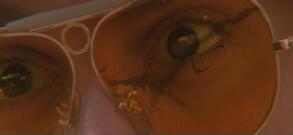 "We start out at full speed and it's WOOOO! The drug kicks in and you're on speed! Whoah! You get the buzz - it's crazy, it's outrageous, the carpet's moving and everybody's laughing and having a great time. But then, ever so slowly, the walls start closing in and it's like you're never going to get out of this fucking place. It's an ugly nightmare and there's no escape. And then they get out into the desert and it's light again. But it's a really rough ride for a lot of people to climb inside that head."
"We start out at full speed and it's WOOOO! The drug kicks in and you're on speed! Whoah! You get the buzz - it's crazy, it's outrageous, the carpet's moving and everybody's laughing and having a great time. But then, ever so slowly, the walls start closing in and it's like you're never going to get out of this fucking place. It's an ugly nightmare and there's no escape. And then they get out into the desert and it's light again. But it's a really rough ride for a lot of people to climb inside that head."
Gilliam also felt that the more surreal parts of the book could be transferred onto film if done right. For example, the imaginary bats that Duke sees on the highway at the beginning of the book was one such passage the director felt could be translated into visual terms.
"Right at the start I thought, 'Well, we can't show them in the sky, we can only show them inside Duke's eyeball. So in the film we push in really tight on one of his eyes, where you can see these reflections of bats flapping around. We then cut to a wide shot that shows Duke waving his arms at nothing. I wanted to some how convey that this was an internal problem."
When Gilliam first joined the production there wasn't even a set budget. "I went out there and said all right, to start with just double it, whatever the budget is, seven and a half? I want $15-million, whatever it is just double it. And at the same time we're running around doing location scouts, discovering we can't use this, which we thought we could use, and we're trying to invent everything at the same time. I've never done a film like that, but on the other hand that was part of the fun of this one."
From there, the pace never slackened as Gilliam and company shot Fear and Loathing on location in a fast 56 days on a lean budget (by Hollywood standards) of $18.5 million. "One of the reasons I made this film," Gilliam remembers, "was to push myself and see if I could still work the way I used to: fast, furiously and cheaply."
THE LOOK
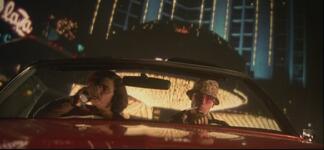
Visually, Fear and Loathing is a masterpiece with a whacked out kaleidoscope of colours and insanely inventive camera angles and perspectives that make you feel like you're actually on drugs. Each drug consumed by Duke and Dr. Gonzo had its corresponding cinematic look to simulate its effects on the characters' perception. As the film's cinematographer, Nicola Pecorini points out, the effect of ether was done with "loose depth of field; everything becomes non-defined," while the effects of amyl nitrate were done so that the "perception of light gets very uneven, light levels increase and decrease during the shots."
The look of Fear and Loathing was not inspired by Ralph Steadman's famous artwork that accompanied Thompson's words. Robert Yarber, an artist who paints pictures of people inside hotel rooms using fluorescent colours, influenced the look of the movie. His paintings captured the hallucinatory feel that the filmmakers were looking for: "the paintings use all kinds of neon colors, and the light sources don't necessarily make sense," Pecorini said in an interview in American Cinematographer magazine. As Gilliam remembers, "people inside hotel rooms in really fluorescent colors. His work is very strange and extraordinary and the colors he uses are extremely vibrant. We used him as a guide while mixing our palette of deeply disturbing fluorescent colors." This is evident in the scenes set in hotel rooms that each have their own garish Las Vegas decor that Duke and Dr. Gonzo subsequently transform into a twisted disaster area.
DEPP BECOMES DUKE
Actor Johnny Depp first met Thompson in Aspen, Colorado just before New Year's Eve, 1995. Depp left that initial meeting wondering why Fear and Loathing had not been made into a film. The actor subsequently invited Thompson to do a one-night gig at Depp's nightclub, The Viper Room on September 29, 1996 with the intention of asking the writer about doing a film version of his book. The opportunity never materialized but the two began corresponding via faxes.
Early one day, Thompson called Depp on the phone and asked him if he would consider playing Raoul Duke if a film was ever made of Fear and Loathing. "Without hesitation, I said, 'You bet!'" Depp recalls. By the Spring of 1997, Depp had moved into the basement of Owl Farm, Thompson's home in Aspen in order to do proper research for the role.
Depp was given complete access to every memento the writer saved from his 1971 trip to Las Vegas. "We went through the manuscript and the notes. There's notes on napkins and everything. He saved it all." The actor read through the writer's notebooks (which included an unpublished chapter entitled, "The Coconut Scene," which Gilliam placed in the film) only to realize that "the freakiest thing was that it was all real, that the reality was as insane as the book."
Thompson was disappointed that the film's costume designer wanted Depp to wear "bizarre Hawaiian zoot suits, and shit like that." The writer let Depp rummage through his wardrobe at the time of the book: Hawaiian shirts, a patchwork jacket, a safari hat, and a silver medallion given to him by Acosta. Thompson graciously allowed Depp to wear it all in the film. Gilliam remembers that the actor would "come back from Hunter's house with shirts and bags that Hunter had taken on the trip. In fact, Johnny drove the original Red Shark - the 1971 Chevrolet convertible in the film - down to Vegas from Hunter's house in Colorado."
All of these items only enhance Depp's performance. In the film, he has literally transformed into Duke/Thompson, complete with the man's unusual bow-legged walk, sweeping arm movements, mumbling speech pattern, and the trademark Dunhill cigarettes in a holder between clenched teeth. It's an incredible performance that transcends simple mimicry.
Depp's research culminated after a week when Thompson shaved almost all of the actor's hair for the film and entrusted him with the very car he used in the trip. The actor soon became Thompson's roadie and in charge of security for The Proud Highway (a collection of Thompson's letters) book tour.
If anything, the concern was that Depp would get too into the role and never emerge intact afterwards. While making the film, the actor received a phone call from Bill Murray who had also spent a lot of time with Thompson while researching for his role in Where The Buffalo Roam. Murray had had a very hard time shaking Thompson's distinctive persona after filming ended. When the comedian returned to Saturday Night Live for the fifth season, "he had virtually become Hunter Thompson, complete with long black cigarette holder, dark glasses, and nasty habits." Murray warned Depp to "be careful or you'll find yourself ten years from now still doing him...Make sure you're next role is some drastically different guy." Depp seemed to heed Murray's advice and went off to do The Astronaut's Wife (1999), a lackluster rip-off of Rosemary's Baby (1968), where he played an astronaut who is possessed by an alien entity.
THE PROBLEMS
"I don't think it was a well-organized film. Its birth was not easy. Certain people didn't...I'm not going to name names but it was a strange film, like one leg was shorter than the other. There was all sorts of chaos." - Terry Gilliam
One of the biggest obstacles Gilliam faced while shooting Fear and Loathing was working in the casinos in Las Vegas. He was only give six tables to put extras around and "the only time they'd give us was between two and six in the morning. And they insisted that the extras did real gambling!" In order to alleviate this problem, Gilliam decided to shoot the exterior shots of the Bazooka Casino in front of the Stardust hotel/casino with the interiors built and filmed on a Warner-Hollywood soundstage. That way, the director could exert more control over his surroundings instead of relying on the casinos that weren't always that co-operative.
Gilliam couldn't even afford the music rights to the Rolling Stones song, "Sympathy For The Devil," which is featured so prominently in the book. The price tag for the song was $300,000 (one third of the soundtrack budget) so they decided to use "Jumpin' Jack Flash" instead.
Another problem was Thompson himself. Gilliam decided to have the writer make a small cameo in the film but feared having him on the set because of the potential chaos the man could create. "Hunter is an uncontrollable force - he is chaos, you can't predict what he'll do next. So me, Johnny and his girlfriend were like three sheepdogs, herding Hunter into position."
To make matters worse, Gilliam faced another battle after Fear and Loathing was made. The Writer's Guild of America wanted to give sole writing credit to Alex Cox and Tod Davies even though Gilliam and Toni Grisoni had written their own script. According to WGA rules, if you're a writer-director, you have to produce more than 50% of the script, while other writers involved only have to produce 30%. However, as Gilliam pointed out, "there have been at least five previous attempts at adapting the book, and they all come from the book. They all use the same scenes." The WGA determined that Gilliam and Grisoni had not written the film. To add insult to injury, Gilliam wasn't even allowed to know who the arbiters were that made the decision or see their reports.
Universal brought in their lawyers and Gilliam and Grisoni had to write a 25-page document to prove that they had written more than 60% of the film. By early May 1998, the WGA revised its decision and gave writing credit to Gilliam and Grisoni first and then Cox and Davies second. This hardly satisfied Gilliam who burned his WGA card in protest.
THE AFTERMATH
"I always get very tense in those (test screenings), because I'm ready to fight. I know the pressure from the studios is, 'somebody didn't like that, change it!'" - Terry Gilliam
To say that Fear and Loathing in Las Vegas received a mixed reaction from audiences and critics alike is a gross understatement. Perhaps Terry Gilliam and company made too faithful an adaptation that only really appeals to devotees of the book. Or, as Gilliam suggests, people were scared off because they had to think about what they were watching. "You've got to work out what it's told you, and that's not what America's about. They want their morality clear."
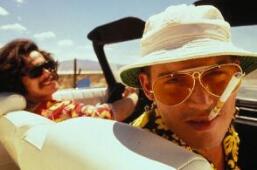 Gilliam found that the American press refused to "even talk about Fear and Loathing. They won't say, 'Ban the film' - they're too liberal for that - so instead they seem to have adopted this attitude of, Oh, maybe if we don't talk about it, it'll go away. That's modern America all over." And judging by Fear and Loathing's quick demise at the box office and subsequent disappearance from theatres, this strategy worked. While most critics praised Depp and Del Toro's performance, most found Gilliam's film to be a muddled mess with no coherent structure: just one long debauched road trip.
Gilliam found that the American press refused to "even talk about Fear and Loathing. They won't say, 'Ban the film' - they're too liberal for that - so instead they seem to have adopted this attitude of, Oh, maybe if we don't talk about it, it'll go away. That's modern America all over." And judging by Fear and Loathing's quick demise at the box office and subsequent disappearance from theatres, this strategy worked. While most critics praised Depp and Del Toro's performance, most found Gilliam's film to be a muddled mess with no coherent structure: just one long debauched road trip.
Regardless of what the critics thought, Gilliam hoped that one person would at least appreciate his efforts: Hunter S. Thompson. "Yeah, I liked it. It's not my show, but I appreciated it. Depp did a hell of a job. His narration is what really held the film together, I think. If you hadn't had that, it would have just been a series of wild scenes," Thompson said in an interview.
Gilliam remembers Hunter's reaction to the film when he saw at the premiere: "He was making all this fucking noise! Apparently it all came flooding back to him, he was reliving the whole trip! He was yelling out and jumping on his seat like it was a rollercoaster, ducking and diving, shouting "SHIT! LOOK OUT! GODDAM BATS!"
I think that this is indeed some kind of genius film, but in a really demented way that I would have a hard time verbalizing to someone who didn't tap into what Gilliam is trying to do. I can see why Fear and Loathing received a critical shellacking from all the usual pundits (Ebert et al.). It's a very odd film - a 128-minute acid trip from beginning to end with no respite, no rest stops, and no objective distance from which to view the whole insane picture safely. You are plunged headlong into this weird, wild world along with the characters.
Fear and Loathing contains many funny moments, bits of dialogue, and visual zingers as Duke and Dr. Gonzo make their way through the surreal landscape that is Las Vegas. The humour in this film is simultaneously disturbing and hilarious - a pitch-black satire of American culture and excess.
Around the 3/4-way mark, Fear and Loathing veers off into some really dark territory as the horror that accompanies chemical dependency rears its ugly head. I was worried that this element would be lost in the transfer from book to film and that it was going to be simply a "straight" comedy. Thankfully, the darker edge of the book has been retained and reinforced in spades.
The heart of darkness in Fear and Loathing is a scene that takes place in the North Star Coffee Lounge between Duke, Dr. Gonzo and a waitress whom the attorney threatens. As Gilliam observes, "this is two guys who have gone beyond the pale, this is unforgivable - that scene, it's ugly. My approach, rather than to throw it out, was to make that scene the low point."
This is the kind of film that people will either really love or hate - there is no middle ground. Gilliam's film is going to be one of those movies that's destined to become an instant cult item. As Hunter S. Thompson puts it in the book, "there he goes, one of God's own prototypes. A high-powered mutant of some kind, never even considered for mass production. Too weird to live, too rare to die." Fear and Loathing in Las Vegas is pure Gonzo filmmaking for people who like weird, challenging films.
Copyright (c) 2005 erasing clouds |
|